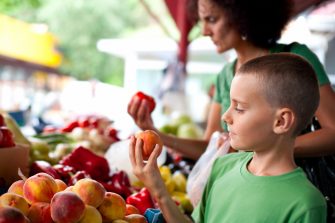Do I Have To DRINK That Much Water?!
 Eight glasses of water… Every day… It’s no wonder people get frustrated with health advice to drink water. True, many people do not get enough water and that can have a variety of negative effects on the body ranging from feeling thirsty and headaches to shock and, in severe cases, even death. However, when faced with the thought of eight glasses of water, many people get frustrated and give up before they begin.
Eight glasses of water… Every day… It’s no wonder people get frustrated with health advice to drink water. True, many people do not get enough water and that can have a variety of negative effects on the body ranging from feeling thirsty and headaches to shock and, in severe cases, even death. However, when faced with the thought of eight glasses of water, many people get frustrated and give up before they begin.
What would you think if you could EAT some of that water? What if tasty, sweet, refreshing foods could help you supplement that daily H2O requirement? Wouldn’t that be easier? And more enjoyable?
Well, you’re in luck because that’s exactly what you can do! While summer is a time when people typically need additional water to combat the heat, it’s also the time when many of these wonderful “water foods” are in season! Take a look at some of the tasty options available.
CUCUMBER
This vegetable is 96% water! Plus, cucumber has vitamins and anti-inflammatory compounds. Some research shows it may have anti-aging properties as well. Cucumbers are easy to find year round at grocery stores. During the summer time, they are often a staple at roadside stands, farmers markets and a popular choice for backyard gardens.
CELERY
Celery is right up there with cucumbers as one of the highest water content foods. Not only is celery 95% water, it is low calorie and has high vitamin K, folate and potassium. Celery may hydrate your body FASTER than a glass of water according to some researchers due to the combination of amino acids, mineral salts and vitamins with the high-water content.
LETTUCE/SPINICH
Iceberg lettuce is 95% water making it a great base for your summer salad or as a substitute for bread/tortillas for making wraps. Bump up your vitamins with only a slight decrease in water by using other lettuce greens such as romaine (most are around 94% water).
Another option is spinach. With 91% water, it is still a great hydrating food, along with being a great a source of vitamin A, vitamin C and even protein! If you have not branched out to the assorted lettuce types, start with a base of iceberg or romaine. Get a small quantity of a new-to-you variety of lettuce and mix it in. As you discover which flavors you enjoy the most, you can alter your salad to include more of the higher vitamin greens. Spinach is also commonly used in healthy smoothie recipes.
ZUCCHINI
Like cucumbers, zucchini is easy to find from local growers in the summer season. It is very high in water content (nearly 95%) along with numerous vitamins including anti-oxidants and minerals that are good for eye health. With its mild flavor, zucchini can be mixed into other foods to “sneak” more veggies into meals and can even be spiralized and used as a substitute for spaghetti noodles.
FRESH FRUIT
Many fruits are also great sources of water as well as vitamins. With their sweet taste, they can be a healthy dessert or snack for children and adults alike. Some like watermelon (91% water), cantaloupe (90%), strawberries (92%), raspberries (86%), pears (84%) and grapes (80%) may be found with local growers and markets. Other, more tropical fruits such as oranges (87% water), bananas (75%), grapefruit (90%), mango (83%), kiwi (83%) and pineapple (86%) can be found at your grocery store.
OTHER VEGETABLES
You probably assume that tomatoes are high in water (94%), and rightly so. But did you know cauliflower is 92% water? That’s as much as bell peppers (92%), and even more than carrots (88%). Broccoli is surprisingly high with 89% water. A recent addition to more popular vegetables is spaghetti squash, with almost 92% water. Don’t forget onions at 90%. They are great for seasoning meats and chopping on salads.
As this list shows, you have a variety of options to get the water your body needs while still adding color, vitamins, and other nutrients to your diet. As an added plus, many fresh fruits and vegetables are high in fiber, adding to the bulk and helping you feel full without adding empty calories.
Next time you see a vegetable stand or farmers market in your area, stop and see what’s available. It may change frequently – even daily – as the foods reach maturity. In season vegetables are often less expensive, so summer is a great time to experiment with new vegetables and recipes.
Fresh fruits and vegetables are great for summer salads, smoothies and just to eat as snacks. You can also get extra and preserve them yourself for later in the year. If you have nutritional questions, talk to your doctor of chiropractic at your next visit. If you don’t have a chiropractor, you can find a TCA member doctor HERE
REFERENCES:
National Nutrient Database for Standard Reference Legacy Release. https://ndb.nal.usda.gov/ndb/search/list?SYNCHRONIZER_TOKEN=968d8f3d-ff9c-472d-b676-c16644ea7d98&SYNCHRONIZER_URI=%2Fndb%2Fsearch%2Flist&qt=&qlookup=&ds=&manu=
“How Much Water is in Your Food?” Berkeley Wellness. March 1, 2011. http://www.berkeleywellness.com/healthy-eating/food/article/how-much-water-your-food
Lerner, Abby. “Top 30 Hydrating Foods: These healthy snacks not only replenish your fluids, they deliver other body benefits too.” https://www.shape.com/healthy-eating/healthy-drinks/top-30-hydrating-foods
Kirkpatrick, MS, RD, LD; B. Titgemeier, MS, RDN. “Dehydrated? These 7 Foods Will Satisfy Your Thirst and Hunger: Treat your taste buds and replenish your water.” July 29, 2014. https://health.clevelandclinic.org/dehydrated-these-7-foods-will-satisfy-your-thirst-and-hunger/